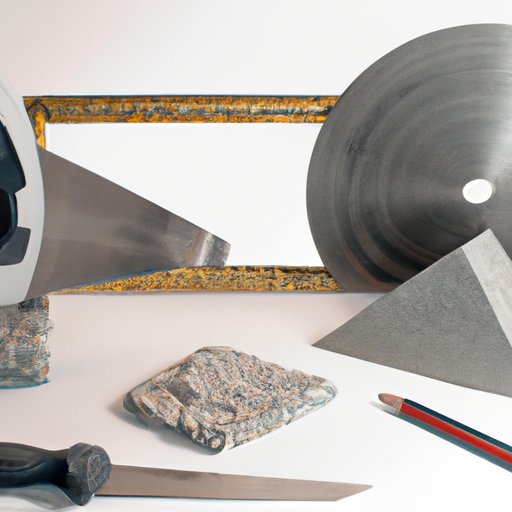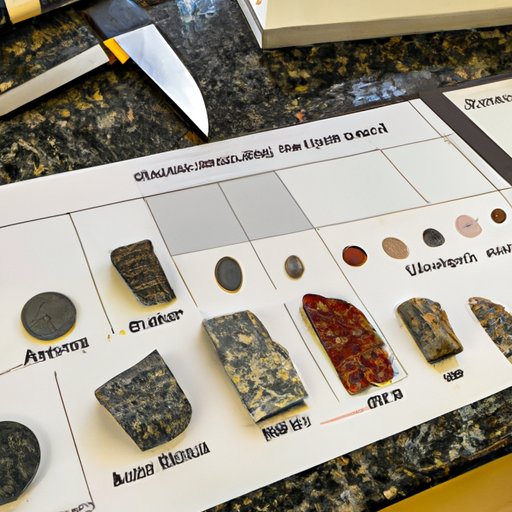
Introduction
Granite has become one of the most popular materials for countertops and flooring due to its durability, versatility, and aesthetic appeal. However, cutting granite can be a challenge due to its hardness and density. If you’re planning on cutting granite for a home project, it’s important to learn how to do it safely and accurately. This article will provide a step-by-step guide to cutting granite using a diamond blade saw, top tips for cutting without damaging the surface, advice on choosing the right tools for various shapes and types of granite, and more.
Step-by-Step Guide on Cutting Granite Using a Diamond Blade Saw
Cutting granite requires the use of a diamond blade saw, which can be rented or purchased at most hardware stores. Here are the steps for cutting granite with a diamond blade saw:
Gather the necessary tools and equipment
Before starting, make sure you have all the necessary tools and equipment, including a diamond blade saw, safety goggles, earplugs, a respirator mask, a level, a measuring tape, a pencil, clamps, and a straight edge.
Prepare the workspace and measure accurately
Clear the workspace of any debris or materials that may obstruct your work. Measure and mark the granite with a pencil to ensure accuracy when cutting. Use a level and straight edge to mark straight lines if needed.
Set up the diamond blade saw and adjust the depth
Set up the diamond blade saw according to the manufacturer’s instructions, and adjust the depth of the blade to the thickness of the granite you’re cutting.
Make the initial cuts and follow the marked lines
Turn on the saw and make the initial cuts along the marked lines. Make sure to follow the lines precisely and with steady pressure. It’s important not to force the blade, as this can cause damage or injury.
Smooth out the edges and corners
Once the initial cuts have been made, use a grinding tool to smooth out any rough edges or corners. Be sure to wear proper safety gear and keep the blade cool by frequently dipping it in water.
Clean the workspace and inspect the finished cut
After the cutting and grinding are finished, clean the workspace to remove any leftover dust or debris. Inspect the finished cut to ensure that it meets your specifications and needs.
Top Tips for Cutting Granite Without Damaging the Surface
Cutting granite can be tricky, and it’s important to take precautions to avoid damaging the surface. Here are some top tips for cutting granite safely and effectively:
Use an appropriate blade and technique for the type of granite
Different types of granite require different types of blades and cutting techniques. Be sure to use a blade that’s appropriate for the density and hardness of the granite you’re cutting, and use a technique that’s appropriate for the shape and size of the area you’re working with.
Keep the blade cool and avoid overheating
Overheating can cause the blade to warp or lose its edge, which can lead to damage or injury. Keep the blade cool by frequently dipping it in water or using a coolant spray.
Use steady pressure and avoid forcing the blade
Forcing the blade can damage the granite or cause injury. Use steady pressure and let the blade do the work.
Avoid cutting through fissures or weakened areas in the granite
Fissures and weakened areas can cause the granite to break or split, so it’s important to avoid cutting through them.
Stop and inspect the cut frequently to avoid mistakes and damage
Stopping to inspect the cut frequently can help you catch mistakes and prevent damage or injury.
Choosing the Right Tools for Cutting Granite in Various Shapes
Different shapes and sizes of granite require different tools for cutting. Here are some tools to consider for various shapes and sizes:
Different types of saws and blades for various shapes and sizes
Circular saws and diamond blades are best for cutting straight lines and larger areas, while smaller saws and blades are better for curved or intricate shapes.
Hand tools for more intricate designs and cuts
Hand-held tools like chisels, hammers, and files can be used for more intricate designs and cuts.
Specialized tools for curves, corners, and angles
Specialized tools like tile nippers, angle grinders, and stone routers can be used for curves, corners, and angles.

Explaining the Different Types of Granite and How to Cut Them Properly
Different types of granite have different properties that affect how they should be cut. Here are some tips for cutting various types of granite:
Differences in durability, hardness, and color
Some types of granite are more durable and harder than others, which can affect the type of blade and technique used for cutting. Color can also indicate the density and durability of the granite.
How to approach cuts for dense and porous granite
Dense granite requires a slower cutting speed and a diamond blade with a higher concentration of diamonds. Porous granite should be cut with a diamond blade that has fewer diamonds to avoid clogging.
Tips for cutting layers or patterns in granite
Cutting through layers or patterns in granite requires a diamond blade with a high concentration of diamonds and a delicate touch to avoid damaging the surface.
Preparing Your Workspace and Measuring Accurately Before Cutting Granite
Preparing your workspace and measuring accurately before cutting granite can help ensure accuracy and safety. Here are some tips for preparing your workspace:
Cleaning and organizing the workspace
Clearing the workspace of any debris or materials can help prevent accidents and ensure accuracy.
Measuring and marking the granite to avoid mistakes
Measuring and marking the granite with a pencil can help ensure accuracy and prevent mistakes.
Checking the equipment and blade before starting
Making sure the equipment and blade are in good working condition can help prevent accidents and ensure accuracy.
Safety Precautions to Take When Cutting Granite to Avoid Injury
Cutting granite can be dangerous, and it’s important to take proper safety precautions to avoid injury. Here are some safety precautions to take:
Wearing appropriate safety gear
Wearing safety goggles, earplugs, a respirator mask, and other appropriate safety gear can help prevent injury.
Using caution and focus while cutting
Using caution and focus while cutting can help prevent accidents.
Keeping others away from the workspace
Keeping others away from the workspace can help prevent accidents and injury.
Turning off and safely storing equipment when finished
Turning off and safely storing the equipment when finished can help prevent accidents and ensure that the tools are ready for the next use.
Common Mistakes to Avoid When Cutting Granite for the First Time
Cutting granite for the first time can be challenging, and it’s important to avoid common mistakes. Here are some mistakes to avoid:
Rushing or forcing the cuts
Rushing or forcing the cuts can cause the blade to warp or lose its edge, which can lead to damage or injury.
Using the wrong blade or saw for the job
Using the wrong blade or saw for the job can cause damage or injury.
Not measuring or marking accurately
Not measuring or marking accurately can lead to mistakes and uneven cuts.
Ignoring safety precautions
Ignoring safety precautions can lead to accidents and injury.
Conclusion
Cutting granite can be challenging, but with the right tools, techniques, and precautions, it can be done effectively and safely. Remember to take the necessary safety precautions, use appropriate tools and techniques for the type of granite you’re cutting, and measure and mark accurately. With preparation and patience, you can successfully cut granite for your home projects and enjoy its beauty and durability for years to come.





